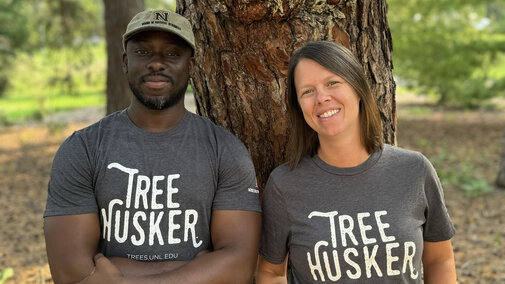Lord Ameyaw recently received a $682,335 Conservation Innovation Grant to study and test alley cropping, a farming method including rows of trees in agricultural fields.
The forester and assistant professor in the School of Natural Resources said his project includes comparing various designs of alley cropping and the benefits of each. He and Ann Powers, a forestry lecturer and co-investigator, plan to test alley-cropped fields for drought and wildfire resilience and look at policy and tax incentives that either promote or deter its use.
“The project is ambitious,” Ameyaw said. “That’s what we all thought when we were putting it together. It’s huge.”
The grant is the first major one he has secured and is the first grant Powers has been on. The two run the Regional and Community Forestry program at the University of Nebraska-Lincoln and will carry out the three-year project at the Horning State Farm near Plattsmouth.
The farm has had a 14-acre demonstration site for alley cropping since about 2006. At the site, Chinese chestnut, northern pecan and black walnut trees are planted in rows with about 20 feet between trees in each row. The distance between one row of nut trees to the next row of nut trees is about 40 feet planted with tall grass.
“The idea is that your introducing the trees in those rows creates this kind of microclimate for the understory or the project crops to thrive whilst you're having the tree crop also at the same time,” Ameyaw said. “So, it's some income diversification for the producer or the farmer or the landowner.”
The forester said he will be comparing the 20- and 40-foot layout of the alley-cropped field with other possible layouts to recommend distancing for farmers.
“I've not seen the research that says ‘This is best’ or ‘That is best’ because it varies depending on what trees are in there and what agriculture crops you have,” he said. “So, there's no really standardized number for spacing your trees and crops, but we want to come up with some kind of a sweet spot for any farmer or producer out there."
Regular crops like corn can be planted between the tree rows in alley cropping, but Ameyaw said some configurations, like pecans and apples, do not work well together. He and Powers lack time in the three-year project to plant and grow fruit trees to test. They will, instead, identify and interview farmers using tree-and-crop combinations to weigh costs and benefits.
Ameyaw has already reached out to Mayan farmers in Omaha… (continue reading)

